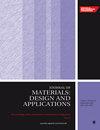Effect of Ag interlayer on the microstructural properties and nanocreep behavior of Ti6Al4V/AA7075 dissimilar laser weldments
IF 2.2
4区 材料科学
Q3 MATERIALS SCIENCE, MULTIDISCIPLINARY
Proceedings of the Institution of Mechanical Engineers, Part L: Journal of Materials: Design and Applications
Pub Date : 2024-03-28
DOI:10.1177/14644207241243351
引用次数: 0
Abstract
Creep failure poses a potential risk in dissimilar welded joints between aluminum and titanium alloys, potentially compromising the joint's integrity. This study utilizes laser beam welding (LBW) to achieve dissimilar joining of AA7075 and Ti6Al4V by incorporating an Ag interlayer. The role of Ag interlayer for dissimilar joining of AA7075 and Ti6Al4V alloys and its impact on the microstructure and nanocreep behavior of joints is examined. The findings showed that the use of Ag decreased the interaction of Ti/Al considerably with each other which led to a reduction in the formation of brittle intermetallic compounds. The nanohardness and atomic force microscopy (AFM) results indicated that the Ti6Al4V HAZ exhibited the highest hardness and least plastic deformation, owing to the formation of α′ martensite. The nanoindentation creep analysis revealed the highest stress exponent value in Ti6Al4V HAZ, pointing to a dislocation climb creep mechanism. Additionally, the results also suggested that the observed creep mechanism might be attributed to both diffusional creep and dislocation climb for other zones.银中间膜对 Ti6Al4V/AA7075 异种激光焊接件微观结构特性和纳米剥蚀行为的影响
蠕变失效是铝合金和钛合金之间异种焊接接头的潜在风险,可能会破坏接头的完整性。本研究利用激光束焊接(LBW),通过加入银中间膜实现 AA7075 和 Ti6Al4V 的异种焊接。研究了AA7075和Ti6Al4V合金异种连接中银中间膜的作用及其对接头微观结构和纳米蠕变行为的影响。研究结果表明,Ag 的使用大大降低了 Ti/Al 之间的相互作用,从而减少了脆性金属间化合物的形成。纳米硬度和原子力显微镜(AFM)结果表明,由于形成了 α′ 马氏体,Ti6Al4V HAZ 的硬度最高,塑性变形最小。纳米压痕蠕变分析表明,Ti6Al4V HAZ 的应力指数值最高,表明存在位错攀升蠕变机制。此外,研究结果还表明,在其他区域观察到的蠕变机制可能同时归因于扩散蠕变和位错攀升。
本文章由计算机程序翻译,如有差异,请以英文原文为准。
求助全文
约1分钟内获得全文
求助全文
来源期刊

CiteScore
4.70
自引率
8.30%
发文量
166
审稿时长
3 months
期刊介绍:
The Journal of Materials: Design and Applications covers the usage and design of materials for application in an engineering context. The materials covered include metals, ceramics, and composites, as well as engineering polymers.
"The Journal of Materials Design and Applications is dedicated to publishing papers of the highest quality, in a timely fashion, covering a variety of important areas in materials technology. The Journal''s publishers have a wealth of publishing expertise and ensure that authors are given exemplary service. Every attention is given to publishing the papers as quickly as possible. The Journal has an excellent international reputation, with a corresponding international Editorial Board from a large number of different materials areas and disciplines advising the Editor." Professor Bill Banks - University of Strathclyde, UK
This journal is a member of the Committee on Publication Ethics (COPE).
 求助内容:
求助内容: 应助结果提醒方式:
应助结果提醒方式:


